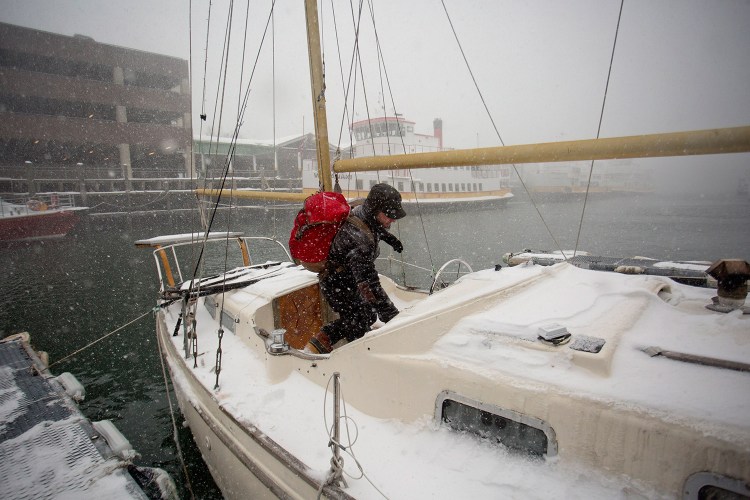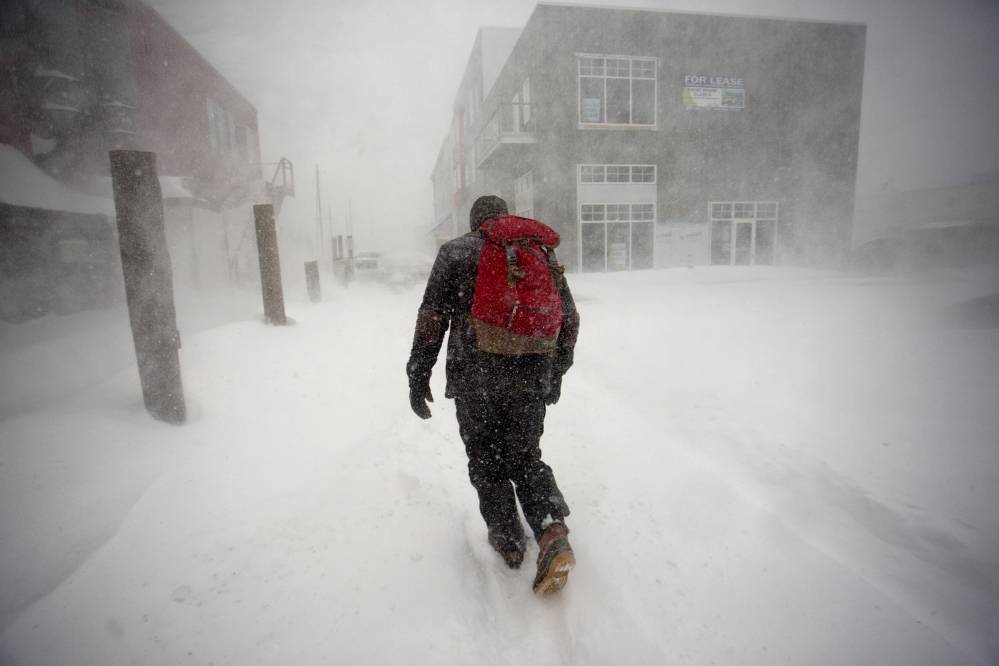Jack Marrie fell asleep aboard his sailboat as it gently rocked in its slip on the Portland waterfront, before the first flakes of Tuesday’s blizzard began to fall.
In the morning he emerged from the cabin, which is heated by a tiny wood stove he installed last year, to sweep away the piles of snow that accumulated on the deck overnight.
“I wish there was just someone to see (my) face pop out the door,” Marrie said, restoking the fire later Tuesday morning. “It was just what I hoped for. I like a good storm.”
He did nothing special to prepare his uncovered 30-foot ketch for the storm that gusted through Portland, bringing high winds and dropping more than 18 inches of snow on the city.
That may seem like a cavalier attitude to those who can’t imagine wintering aboard a boat in a place like Maine, let alone doing so in a blizzard.
But Frank Connelly and Sue Polans also found they could ride out the storm without too much discomfort, so they stayed aboard their 52-foot trawler Emma at South Port Marine in South Portland.
“We were getting pounded this morning,” Connelly said Tuesday. “The boat was moving pretty good” in spite of the many lines holding it tight to the dock.
“The wind sounded like they had a jet flying overhead,” he said, although the shrink wrap encasing the boat held up well.
Inside, just a couple of cabinets popped open. Their electric heater was keeping up with the cold.
Most of the 10 or so live-aboards at South Port Marine had left for the day, so Connelly went down to the dock to check on their boats.
He talked with one owner about replacing a couple of dock lines that had parted under the stress of the storm. On another boat, the shrink-wrap housing, which can cost more than $1,000, was starting to tear.
“There’s nothing we can do about it right now,” Connelly said. “It’s just too dangerous to get out there and mess with it.”
Just walking the docks was a gamble – one he only takes while wearing a float coat, in case he goes over.
“The problem with walking up and down the dock is the wind. I tried to go up earlier, the wind was so strong, it was practically blowing me over,” he said.
LIFE IS GOOD ON BOARD YEAR-ROUND
Back on the Portland waterfront, Marrie said many people offer him a place to stay on land during storms, but that’s exactly when he wants to be on the boat, to make sure nothing goes wrong. If the bilge pump stops working, for example, he needs to be there to fix the problem.
Marrie, 30, lives aboard his boat year-round. He has no running water or electrical hookup at his winter slip. To him, this is just how life is since he decided to stay on the water full time after he bought the boat, the Rime, two years ago.
This winter, his slip is located behind Flatbread Company on Commercial Street, partially sheltered by the restaurant building and the wall of the adjacent pier. He can step directly off the boat onto the dock and walk to work at Longfellow Books in Monument Square.
“I think people are often surprised,” Marrie said. “It doesn’t take anything really remarkable. It’s just deciding to do it. Once you commit to living aboard a boat, it kind of becomes your life.”
The cabin of his 1972 Reg Freeman boat isn’t spacious, but Marrie discovered that buying his own boat for $6,500 and living there rather than renting and sharing an apartment with roommates was much more affordable.
SUMMER ROUGHER IN SOME WAYS
Near the height of Tuesday’s storm, the wind whipped the wire stays supporting the masts, and small ice floes swirled around the hull. But inside was quiet and warm, the boat rolling from side to side less than a rocking chair.
“I think people are surprised, when they come aboard, how comfortable it can be. There are a few indignities, but not without romance,” Marrie said. “The winter is mellow. To me, it’s basically like I’m on land. On a slip is just very secure.”
Marrie is a native of central Kentucky. His first experience living on a boat was after he had “fallen in with a bunch of boat dorks” while living in Port Townsend, Washington. Those friends invited him on a two- to three-month voyage in the Sea of Cortez in Mexico on a 35-foot sailboat.
He later moved to Maine to attend a boat and furniture apprenticeship program at The Carpenter’s Boat Shop in Pemaquid. Afterward, he lived on Peaks Island with his younger sister, Mackenzie, and then on the Portland mainland before buying the Rime.
In summertime, living on a boat can in some ways be rougher than in winter. Marrie has to row a dinghy back and forth to his mooring, and storms can be more severe on the open water than on the winter slip.
“In the summer you get hurricanes, and they are much more rambunctious than this,” Marrie said, referring to the blizzard.
SAFETY FIRST – AT A HOTEL
Some live-aboards, such as David and Jane Jameson, opted to seek refuge in a hotel after making sure their 38-foot sailboat, So Far So Good, was extra secure.
“When we heard hurricane-force winds, we said: ‘Our lives or the boat?’ We’re going to go with our own safety first,” Dave Jameson said. “I’ve been on the boat three years full time and this is the first time we’ve gone to a hotel.”
He spent time Monday securing his vessel as best he could. “It looks like spiderwebs, there are so many lines going to so many cleats,” he said.
The worst weather hits two hours to either side of high tide, when the natural shoals lining Portland Harbor offer no protection, he said.
“The higher the tide, the more the waves can get at us,” he said. “What you have to worry about is the splashover on the docks. That will freeze like black ice. When it gets icy, a slip into the bay could be fatal, so live-aboards keep strap-on cleats in the car and onboard.”
Sometimes even with cleats, getting back and forth from shore can be a chore.
“At low tide, you have to go down the ramp. If it’s icy, you’re going to take a tumble. Most of us have learned that the hard way,” he said.
MARINAS HAVE TO PREPARE, TOO
Eric Fortier, dockmaster at South Port Marine, said preparation for a storm like Tuesday’s is key: making sure small boats and debris are well clear of the docks; lashing the finger docks together so they are less likely to snap the pins holding them to the main pier; and trying to get the boats pointed as much into the wind as the dock configuration will allow.
Polans, on the Emma at South Port Marine and a member of the U.S. Coast Guard Auxiliary, said all the live-aboards at the marina monitor the same radio channel so that if anyone needs a hand, everyone hears about it right away.
“It’s a nice community down here and we all take care of each other,” she said.
Send questions/comments to the editors.





Success. Please wait for the page to reload. If the page does not reload within 5 seconds, please refresh the page.
Enter your email and password to access comments.
Hi, to comment on stories you must . This profile is in addition to your subscription and website login.
Already have a commenting profile? .
Invalid username/password.
Please check your email to confirm and complete your registration.
Only subscribers are eligible to post comments. Please subscribe or login first for digital access. Here’s why.
Use the form below to reset your password. When you've submitted your account email, we will send an email with a reset code.